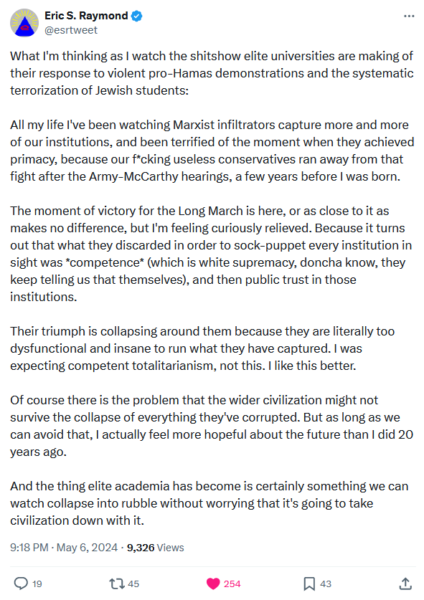 Many primitive societies believe that maleficient spirits cause all sorts of human misfortune that in the modern West we have learned to attribute to natural causes – cattle dying, crops failing, disease, drought, that sort of thing. A few societies have developed a more peculiar form of supernaturalism, in which evil spirits recede into the background and all misfortune is caused by the action of maleficient human sorcerers who must be found and rooted out to end the harm.
Many primitive societies believe that maleficient spirits cause all sorts of human misfortune that in the modern West we have learned to attribute to natural causes – cattle dying, crops failing, disease, drought, that sort of thing. A few societies have developed a more peculiar form of supernaturalism, in which evil spirits recede into the background and all misfortune is caused by the action of maleficient human sorcerers who must be found and rooted out to end the harm.
A society like that may be a grim, paranoid place with everyone constantly on the hunt for sorcerers – but a sorcerer can be punished or killed more easily than a spirit or a blind force of nature. Therein lies the perverse appeal of this sort of belief system, what I’ll call “sorcerism” – you may not be able to stop your cattle from dying, but at least you can find the bastard who did it and hurt him until you feel better. Maybe you can even prevent the next cattle-death. You are not powerless.
[…]
The most puzzling thing about the whole exchange was his insistence on interpreting my talk about the weather as a political move. I report the Central Valley superstorm of 1861-62 and R’s response is “When did you turn into Rush Limbaugh?” Uh, WTF, over?
It took me a while to model the frame of mind that produced this, but when I managed to I had an insight. Which is why I’m writing this essay. I think, now, what I actually threatened was R’s belief that he, or somebody, could do something emotionally satisfying about the bad weather. Fix it, or prevent it from recurring, or at least punish the bastards who did it.
Supernaturalizing the causes of large-scale misfortunes has become a difficult strategy to sustain for anyone with more exposure to modern scientific knowledge than a cinderblock. Politicizing them into someone’s bad juju, however … that’s easy. And, perhaps, more attractive than ever before – because the alternative is to feel powerless, and that is painful.
Science and the increase in our control over our immediate environment at the small scale may, in fact, be driving us back towards a sort of sorcerism by making the feeling of powerlessness more painful. We are children of humanism and the Enlightenment; terror of the storm and dark is something we associate with the bad old days of angry gods. We should be beyond that now … shouldn’t we?
Thus, the politicization of every bad thing that happens. And people like R, for whom “When did you turn into Rush Limbaugh?” becomes a sort of aversive charm to ward off fear of the Central Valley superstorm and its like.
Yes, we need a word for this, too. Not “sorcerism”; “politicism”, perhaps. The insistence on locating for every large-scale problem a human cause that can be addressed through politics and a set of serviceable villains to punish. Also, the insistence that anyone who rejects the politically fashionable explanation must be in league with the evil sorcerers.
Unfortunately, reality isn’t like that. If a supernova goes off within eight parsecs of us and strips off the Earth’s ozone layer it won’t have been Halliburton or the International Communist Conspiracy that did it. And if the Central Valley superstorm does repeat on us – well, statistically that looked pretty likely at a mean interval of about 150 years; welcome to your new normal, and hunting for the evil carbon-or-whatever emitters that did it is highly unlikely to do any more than supplying you with a scapegoat to ease your hurt feelings.
Finally … feeling powerless may suck, but on the whole it’s preferable to sorcerer hunts. People get killed in sorcerer hunts, almost always people who are innocent. One reason I’m not a politicist is that I don’t want to be any part of a howling mob. It’s a form of self-restraint I recommend to others.
Eric S. Raymond, “Heavy weather and bad juju”, Armed and Dangerous, 2011-02-03.






